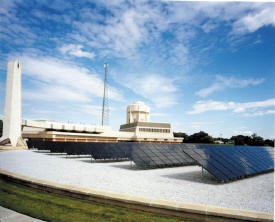New Maryland law will help increase solar in the state
 Renewable energy legislation, which passed in Maryland last year, finally became effective this week.
Renewable energy legislation, which passed in Maryland last year, finally became effective this week.
The legislation should provide a boost to the solar industry in Maryland and is likely to have a modest impact on the state’s residents and businesses in terms of an additional fee on their electric bill.
The legislation, S.B. 277, signed into law last year by Governor Martin O’Malley (D), is likely to add 5 cents a month to residential electric bills and about 66 cents per month to commercial electric bills, according to the Associated Press.
Utilities will either add the generation themselves as they bring more power online in Maryland, or they purchase solar renewable energy credits, otherwise known as SRECs.
The SRECs are owned by the owners of solar-powered systems in Maryland, and the system owners will retain ownership of the electricity produced and sell the SRECs separately. Some of the costs related to the SRECs and the new generation are passed on to electric consumers in the state via the modest surcharge.
The legislation was passed to provide additional guidance to utilities as they start adding more renewable energy into their mix to meet the state’s renewable portfolio standard.
“We have a very ambitious renewable energy state goal of 20 percent by 2022,” Maryland Energy Administration spokesperson Ian Hines said.
Under the new law, the timeline for phasing in the renewable portfolio standard was moved up. Hines explained that there is a phased-in schedule under the standard.
Solar is the only form of renewable energy that has a specific requirement under the legislation.
“By 2022, Maryland must generate 2 percent of our state’s energy from solar sources in order to comply with our renewable portfolio standards," Hines said. "To achieve that goal will take a lot of work, as it will require generating about 100 times more energy from solar than we are today.”
The state doesn’t have an additional carve-out requiring power producers to source some of the solar from distributed generation, like homes and office buildings, Hines explained.
“We’re not particular about the where the solar comes from,” he said.
The largest part of the state’s renewable energy will come from other sources.
“The bulk is going to come from an offshore wind farm,” Hines said.
The proposed 1 gigawatt farm will be built off the coast of Ocean City, Md., a popular vacation spot. The development of the offshore wind farm and a complimentary offshore wind farm project are in the permitting process, Hines said.
Pictured: Solar panels atop Maryland's Federal Center, courtesy of Maryland Energy Administration.



